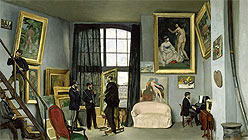
Ilse Bing, Self-Portrait in Mirrors, 1931.
Ms. Miller also very generously took the time to check in with some of the Photoshop instructors who work at ImageWork SF, and continued, “The word is: there is really nothing you can do to prevent image theft from websites. If someone wants an image badly enough they’ll take it. But you can make it much harder and a big deterrent by installing watermark and safety programs. If someone can’t easily drag the image off, and/or has a complicated watermark to Photoshop out, they may just prefer to steal from an easier source. There are many programs available to secure the photos and do watermarks, just do a search and many varieties come up. One program turns the image to a blank white rectangle when dragged off the site; others simply lock the image in place.”
“Also, it’s very important to keep web images as low resolution as possible (without affecting the view on the website) so that even if a photo is grabbed, it is would be way too low res to make clear enlargements or prints from it.”
Don’t forget to add a copyright statement to your website. It’s probably not much of a deterrent to the serious, but at least it broadcasts your intent.

Garry Winogrand, Diane Arbus, Love-In, Central Park, New York City, 1969. c. The Estate of Garry Winogrand, courtesy Fraenkel Gallery, San Francisco.
On the other hand, let’s all note the irony of me giving advice about preventing image theft while using illustrative images found on the internet.

Jacob van Oost the Elder, The Artist’s Studio, 1666.
As a young artist (4 years out from a BFA) maintaining a disciplined and consistent studio practice is of great importance to me and probably where I direct most of my ‘artistic energy.’ What is your idea of a healthy balance between production (of art) and thinking/reading/writing/looking at art? Is constantly producing work a bad thing? Can this harm me?
The wording of your query reminds me of the little tracts on the Sin Of Onanism that the priest would give us in Catholic school. These were always illustrated with pictures of earnest-looking young white kids in sweater sets (no doubt drawn in the mid-sixties), so that’s how I’m imagining you now: sweetly innocent in tennis whites, sitting in front of your easel with brush in hand. And like the illustrated naifs of yesteryear, I suspect that deep down inside you know the answer to your own question.
I’m glad to hear you are disciplined. It’s one of the hardest things to master, so if you’ve got control of your studio habits and schedule you’re already doing well for yourself. And as a young artist it’s important to be in the studio, thinking, working, and experimenting, trying out new ideas and refining older ones. It’s only through the act of making that we are able to hone our ideas, processes and artwork.
So while constantly producing work is not a bad thing (provided you are following reasonable safety guidelines), it’s also not all there is to being a contemporary artist. Being a teacher, of course I think you should read, though I recognize that it’s not for everyone. Some people just don’t enjoy it. But if you do, one way to really get into your reading is to find a book or article that you liked, and then track down and read the references cited in the bibliography. It will lead you deeper into the things that already excite you, and reading — whether it’s theory and criticism or poetry and science fiction — will inspire you, fuelling more thinking and working in the studio.
Likewise, you do need to be getting out of the studio as well. If you’re serious about your practice you should be making friends in your community, because these people will sustain you in your studio work. Conversations can be invaluable, friendship is absolutely necessary for your emotional well-being, and hanging out is fun. So go to gallery openings and parties when you can find them, and take a pal to the free day at the art museum. Studio time often means isolation, and you need to balance that with some human interaction.
Above all, you do need to be looking at art, in person, as often as possible. Beyond just soothing or stimulating your emotions and intellect, looking at art gives you an understanding of ideas and techniques that are currently in play. Looking at work will inform your sense of color, scale, materials, and concept. Looking at the work in person and then reading any accompanying texts will give you ideas about how the work is framed with language and how that may or may not inform your understanding of it.
Your answer is embedded in your question: balance is the key. Only you can determine what works for you, and what activities contribute to your practice of being an artist. Don’t be afraid to experiment, and don’t forget that your situation will change and you can and will adapt your actions to suit.





